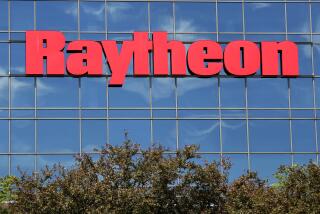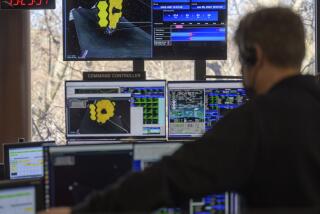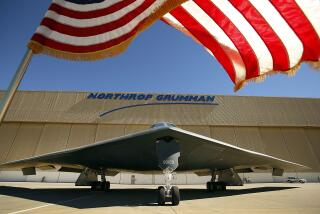Northrop Wins Missile Defense Deal
Northrop Grumman Corp. and Raytheon Co. on Wednesday won a major Pentagon contract potentially worth more than $10 billion to develop and build a new rocket that could destroy ballistic missiles in the early stages of flight.
In a high-profile competition that pitted the nation’s top defense contractors against one another, the Northrop-Raytheon team upset Lockheed Martin Corp. and Boeing Co., both of which have long been the nation’s leading contractors on developing missile defense systems.
The contract to develop and test the so-called kinetic energy interceptor was initially valued at $4 billion over eight years, but analysts said its potential worth would be far greater once production began in 2010, making it one of the more significant programs in missile defense.
“The value could exceed $10 billion,” said Loren Thompson, defense analyst for the Arlington, Va., think tank Lexington Institute. “This is something of a breakthrough for Northrop.”
Since taking the helm of Century City-based Northrop this year, Chairman Ronald D. Sugar has pushed hard to make the company a bigger player in the development of the nation’s missile defense system.
Northrop’s acquisition last year of TRW Inc. for $7.8 billion was seen as a major step toward that goal.
The Pentagon contract “is a very important win for Northrop,” Sugar said during a teleconference call. “It solidifies our position as a contractor in missile defense ... and validates our strategy in the acquisition of TRW.”
Although the contract initially will have little effect on Northrop’s earnings, Sugar said the program eventually “could result in a very significant stream of annual revenue.”
The contract was announced after the stock market closed. In trading Wednesday on the New York Stock Exchange, Northrop shares rose 31 cents to 91.88, while Raytheon increased 34 cents to $28.23.
The Pentagon’s Missile Defense Agency awarded the contract after an eight-month competition in which the teams had to come up with preliminary designs and plans for the rocket.
As a kinetic interceptor, the high-speed rocket would destroy ballistic missiles by smashing into them. The interceptor would travel as fast as 5,000 mph to destroy the missiles within five minutes after their launch.
Analysts said the interceptor could become the cornerstone of the nation’s missile defense system.
The interceptor would be designed to destroy a missile while it was still gaining altitude and before it has had the chance to release its warhead. Any debris would fall back on the country that fired the missile.
The interceptor is one of a number of weapons that the Bush administration wants to build to create a layered defense that can destroy a missile during any phase of its flight.
The administration plans to spend at least $50 billion over the next five years developing the components of the system.
Pentagon officials said the contract was awarded without regard to recent allegations of ethical lapses by Boeing employees. On Monday, Boeing Chairman Philip M. Condit resigned amid allegations of ethical misconduct by two employees on two major defense contracts.
Boeing had competed “without any stigma,” Rick Lehner, a missile defense spokesman told Reuters.
More to Read
Inside the business of entertainment
The Wide Shot brings you news, analysis and insights on everything from streaming wars to production — and what it all means for the future.
You may occasionally receive promotional content from the Los Angeles Times.










